Wood species
On the following pages I try to give a - really short - overview of the woods I use.
Usually all woods used come "from the neighbour's garden" and are stored and dried by me until I can use and carve them. Sometimes there are special rarities, about which I have found only insufficient information, if at all. For example rhododendron or rose root tuber.
The only wood I buy is linden, as I have not found a source in my area yet.
For some of my works I even use glued wood - I will not describe it here. It is a very interesting material. It is a very soft, long fibered wood with a beautiful grain. But see for yourself in the "My works" section.
In most cases when people talk of rose wood, they talk about the wood of the Tuliptree (Dalbergia decipularis). On this page I am talking about the wood of a normal rose (rosa).
the wood is relative soft and has a very interesting grain. Unfortunately it breaks very easy while it is drying. Therfore it is very difficult to carve bigger pieces, but it is easy to carve very nice little things.
.
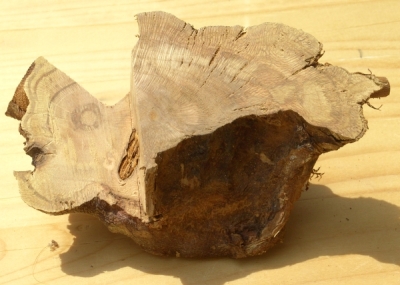
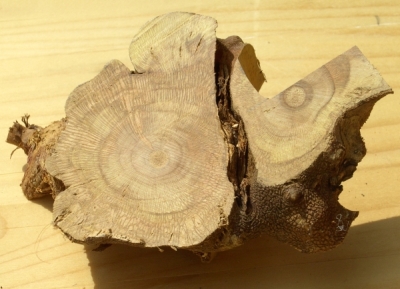
Padouk (Pterocarpus) ist ein Laubbaum, der in ganz Süd- und Südostasien wächst.
Unter der Bezeichnung Padouk wird das Holz verschiedener Bäume aus den Tropen gehandelt. Die gängisten und wahrscheinlich wichtigsten Arten sind:
- Manila-Padouk (Pterocarpus indicus) aus Südostasien
- Burma-Padouk (Pterocarpus macrocarpus) aus Südostasien
- Afrikanisches Padouk, Muninga (Pterocarpus angolensis) aus Zentral- und Ostafrika
- Afrikanisches Padouk, Korallenholz (Pterocarpus soyauxii Taub.) aus Afrika
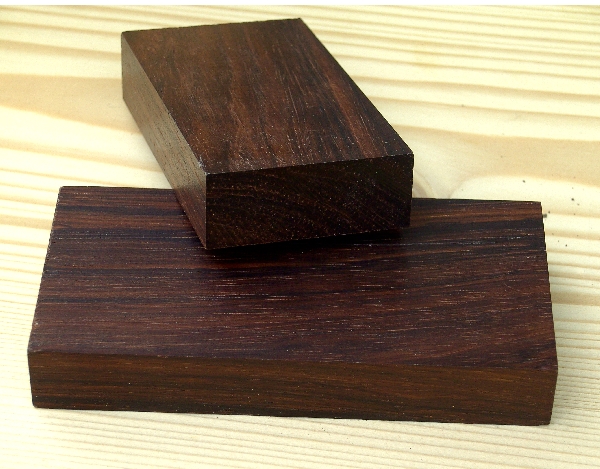 Das Kernholz kann von gelb nach rot vaiieren und ist recht wertvoll und noch dazu hat es meist eine sehr schöne Zeichnung. Das Splintholz unterscheidet sich stark vom Kernholz und ist weit weniger wertvoll.
Das Kernholz kann von gelb nach rot vaiieren und ist recht wertvoll und noch dazu hat es meist eine sehr schöne Zeichnung. Das Splintholz unterscheidet sich stark vom Kernholz und ist weit weniger wertvoll.
Das trockene Holz arbeitet kaum. Eine Besonderheit des Holzes ist, dass gegen den Befall von Pilzen oder Schädlingen resistent ist. Vereinzelt habe ich gelesen, dass es auch gegen Holzschutzbehandlung resistent wäre.
Es gibt im Prinzip zwei Gruppen in die man diese Bäume einteilen kann:
1. Bei der ersten Gruppe ist das Splintholz bis etwa 10 cm breit und weißlich.
Das Kernholz dagegen hat Farben die von korallenrot bis dunkel violettbraun reichen sollen. Allerdings ist diese schöne Farbe nicht von langer Dauer, da es unter dem Einfluß der Sonne verblasst oder sich zu braun verfärbt. Häufig ist der Baum auch wechseldrehwüchsig
2. Bei der anderen Gruppe ist der Slpintbereich etwa 2 bis 4 cm eher gelblich. Das Kernholz ist blaß gelblich bis braun mit dunkelbrauner Streifung oder bei manchen Arten hell goldbraun bis mittelbraun.
Bei Härte und Gewicht des Holzes gibt es teils große Unterschiede. Wobei die Hölzer der erstgenannten Gruppe wesentlich schwerer zu bearbeiten sein soll als die der Zweiten. Bei der erstgenannten Gruppe empfiehlt sich Vorbohren, wenn man Schrauben und Nägel verwenden möchte.
Auf der Oberfläche können nach der Bearbeitung hellgraue, feinem Schimmel ähnliche Ausblühungen auftreten; sie bestehen aus feinsten nadelförmigen Kristallen, aus Pterostilben, und sind leicht abwischbar.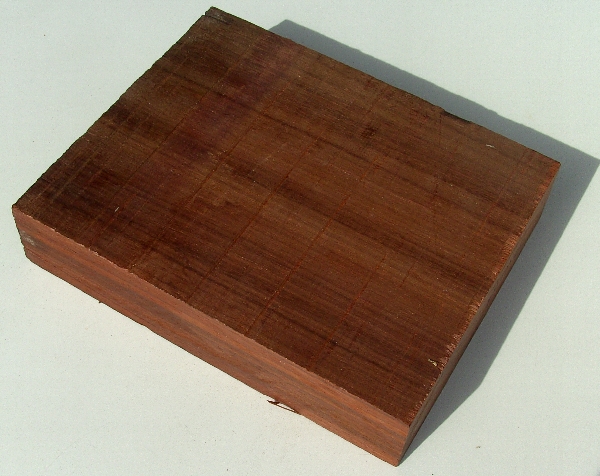
Padouk-Hölzer zeigen ihre oft besondere farbliche Attraktivität sehr gut nach einer halbglänzenden oder glänzenden Behandlung. Hierbei ist zuerst auf einen guten Isoliergrund zu achten, um ein Ausbluten der Inhaltsstoffe zu verhindern und um eine gute Haftung der porenschließenden Mittel zu fördern. Das die roten Farben des Padouk sehr lichtempfindlich sind wird ein besonderer Lichtschutz für dieses Holz ampfohlen.
The Olive (Olea europaea) is an evergreen tree, which can be found around the Mediterranian Sea.
The olive is on of the oldest cultivated plants of mankind. There should be some trees that are hundred years old. Some even several thousand years.
The tree grows very slowly and is about 10-20 meters high.
The wood is dense, hard and durable. Especially whit old gnarled trees, the wood is very nice. Very often the trees have a so called interlocked grain. (Maybe the suffers from interlocked grain? I don't know! If you know, how to say it correctly, please let me know!). 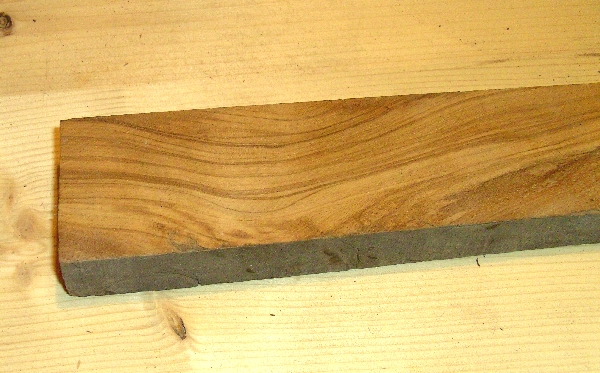 The wood is ver decorative and fine. It is also oilyand therefore it does not swell in water hardly noticable. The color of the wood aooears in countless colors. They range from yellowish to brown, sometimes there are also greens.
The wood is ver decorative and fine. It is also oilyand therefore it does not swell in water hardly noticable. The color of the wood aooears in countless colors. They range from yellowish to brown, sometimes there are also greens.
I've read that no other wood needs that long to dry than olive wood. The rason is the oil. It seems that olive woods tends to crack only in the first few years - 10 years or more, depending on the size.
Genuine Walnut (Juglans regia) 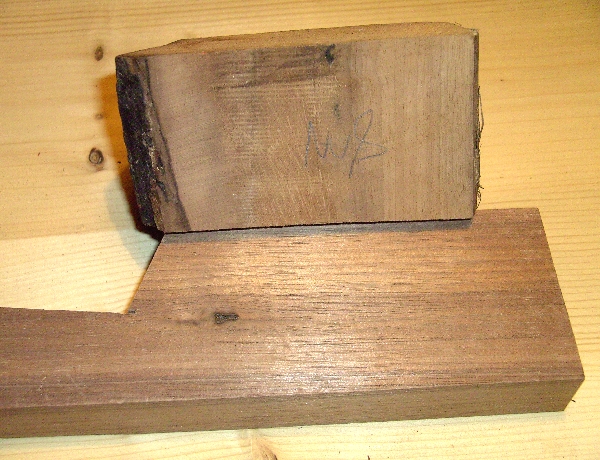
The Walnuttree (Juglandaceae) is a so called Heartwood tree.
Heart- und Sapwood differ significantly: the sapwood is light in color from gray-white to reddish-white. The color of the heartwood ranges from gray to dark brown and depends from location and age of the tree. Due to the distintive growth rings you can see a wonderfull marking.
The most valuable part of the trunk is the lowest, balbous thickened part, that reaches into the soil, the part where the trunk becomes the root , the burl wood.
The wood of the wlanut tree is quite heavy and hard. It is very resistant against bending and it shrinks not much. The power of endurnce is good, but it is only limited weather-resistant. The wood is tuogh and pliable but not elastic. When it is fresch, it shrink mch while drying.
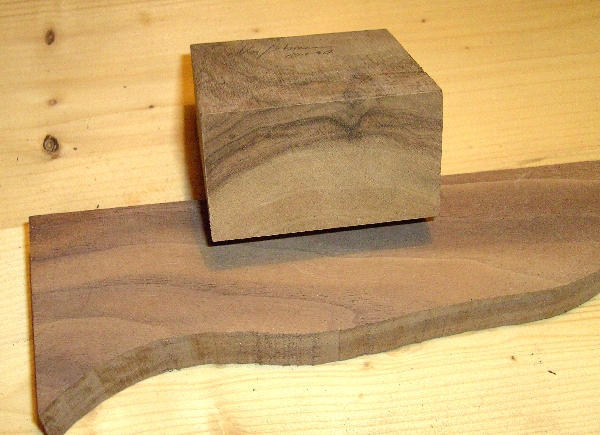 Walnut wood can be finished light and smooth and it is also very well to turn and carve. The treatment of the suface is without problems. When walnut wood gets in contact to iron, it may come to dark colorations aroung the metal.
Walnut wood can be finished light and smooth and it is also very well to turn and carve. The treatment of the suface is without problems. When walnut wood gets in contact to iron, it may come to dark colorations aroung the metal.
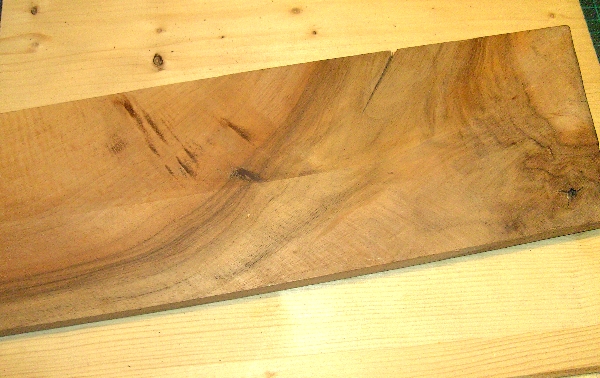
The wood of the Mirabelle (Prunus domestica subsp. syriaca), also known as yellow plum, is a subspecie of the plum (Prunus domestica). It is a very nice wood.
It has mostly very fine, closely spaced annual rings. The sapwood is relatively light, the heartwood is rather dark, however, the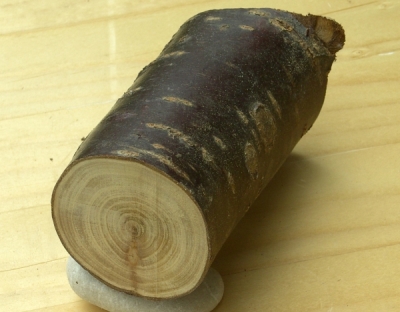 two are not always clearly distinguished. When drying, it unfortunately tends to tear. The wood is hard and tough, suitable for displaying small details.
two are not always clearly distinguished. When drying, it unfortunately tends to tear. The wood is hard and tough, suitable for displaying small details.
Unfortunately, there is nowhere adequately described. I like the grain of this wood. One can achieve very nice effects with it and it can be carved pretty well.
Page 2 of 6



